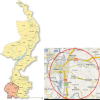Greater exposure to PM2.5 and PM10 was associated with lower corneal nerve measures: the Maastricht study - a cross-sectional study
- PMID: 39232744
- PMCID: PMC11375839
- DOI: 10.1186/s12940-024-01110-1
Greater exposure to PM2.5 and PM10 was associated with lower corneal nerve measures: the Maastricht study - a cross-sectional study
Abstract
Background: Epidemiological and toxicological studies indicate that increased exposure to air pollutants can lead to neurodegenerative diseases. To further confirm this relationship, we evaluated the association between exposure to ambient air pollutants and corneal nerve measures as a surrogate for neurodegeneration, using corneal confocal microscopy.
Methods: We used population-based observational cross-sectional data from The Maastricht Study including N = 3635 participants (mean age 59.3 years, 51.6% were women, and 19.9% had type 2 diabetes) living in the Maastricht area. Using the Geoscience and hEalth Cohort COnsortium (GECCO) data we linked the yearly average exposure levels of ambient air pollutants at home address-level [particulate matter with diameters of ≤ 2.5 µm (PM2.5), and ≤ 10.0 µm (PM10), nitrogen dioxide (NO2), and elemental carbon (EC)]. We used linear regression analysis to study the associations between Z-score for ambient air pollutants concentrations (PM2.5, PM10, NO2, and EC) and Z-score for individual corneal nerve measures (corneal nerve bifurcation density, corneal nerve density, corneal nerve length, and fractal dimension).
Results: After adjustment for potential confounders (age, sex, level of education, glucose metabolism status, corneal confocal microscopy lag time, inclusion year of participants, smoking status, and alcohol consumption), higher Z-scores for PM2.5 and PM10 were associated with lower Z-scores for corneal nerve bifurcation density, nerve density, nerve length, and nerve fractal dimension [stβ (95% CI): PM2.5 -0.10 (-0.14; -0.05), -0.04 (-0.09; 0.01), -0.11 (-0.16; -0.06), -0.20 (-0.24; -0.15); and PM10 -0.08 (-0.13; -0.03), -0.04 (-0.09; 0.01), -0.08 (-0.13; -0.04), -0.17 (-0.21; -0.12)], respectively. No associations were found between NO2 and EC and corneal nerve measures.
Conclusions: Our population-based study demonstrated that exposure to higher levels of PM2.5 and PM10 are associated with higher levels of corneal neurodegeneration, estimated from lower corneal nerve measures. Our results suggest that air pollution may be a determinant for neurodegeneration assessed in the cornea and may impact the ocular surface health as well.
Keywords: Air pollution; Corneal nerves; Elemental carbon; NO2; Neurodegeneration; Particulate matter.
© 2024. The Author(s).
Conflict of interest statement
The authors declare no competing interests.
Figures



Similar articles
-
Effects of long-term exposure to traffic-related air pollution on respiratory and cardiovascular mortality in the Netherlands: the NLCS-AIR study.Res Rep Health Eff Inst. 2009 Mar;(139):5-71; discussion 73-89. Res Rep Health Eff Inst. 2009. PMID: 19554969
-
Mortality and Morbidity Effects of Long-Term Exposure to Low-Level PM2.5, BC, NO2, and O3: An Analysis of European Cohorts in the ELAPSE Project.Res Rep Health Eff Inst. 2021 Sep;2021(208):1-127. Res Rep Health Eff Inst. 2021. PMID: 36106702 Free PMC article.
-
Mortality-Air Pollution Associations in Low Exposure Environments (MAPLE): Phase 2.Res Rep Health Eff Inst. 2022 Jul;2022(212):1-91. Res Rep Health Eff Inst. 2022. PMID: 36224709 Free PMC article.
-
Short-term exposure to particulate matter (PM10 and PM2.5), nitrogen dioxide (NO2), and ozone (O3) and all-cause and cause-specific mortality: Systematic review and meta-analysis.Environ Int. 2020 Sep;142:105876. doi: 10.1016/j.envint.2020.105876. Epub 2020 Jun 23. Environ Int. 2020. PMID: 32590284
-
Association between exposure to ambient air pollution and hospital admission, incidence, and mortality of stroke: an updated systematic review and meta-analysis of more than 23 million participants.Environ Health Prev Med. 2021 Jan 26;26(1):15. doi: 10.1186/s12199-021-00937-1. Environ Health Prev Med. 2021. PMID: 33499804 Free PMC article.
References
-
- Taylor L. WHO cuts air pollution limits to save millions of lives. BMJ. 2021;374:n2349. - PubMed
Publication types
MeSH terms
Substances
Grants and funding
- 31O.041/OP-Zuid, the Province of Limburg, the Dutch Ministry of Economic Affairs
- 31O.041/OP-Zuid, the Province of Limburg, the Dutch Ministry of Economic Affairs
- 31O.041/OP-Zuid, the Province of Limburg, the Dutch Ministry of Economic Affairs
- 31O.041/OP-Zuid, the Province of Limburg, the Dutch Ministry of Economic Affairs
- 31O.041/OP-Zuid, the Province of Limburg, the Dutch Ministry of Economic Affairs
- 31O.041/OP-Zuid, the Province of Limburg, the Dutch Ministry of Economic Affairs
- 31O.041/OP-Zuid, the Province of Limburg, the Dutch Ministry of Economic Affairs
- 31O.041/OP-Zuid, the Province of Limburg, the Dutch Ministry of Economic Affairs
- 31O.041/OP-Zuid, the Province of Limburg, the Dutch Ministry of Economic Affairs
- 31O.041/OP-Zuid, the Province of Limburg, the Dutch Ministry of Economic Affairs
- 31O.041/OP-Zuid, the Province of Limburg, the Dutch Ministry of Economic Affairs
- 31O.041/OP-Zuid, the Province of Limburg, the Dutch Ministry of Economic Affairs
- 31O.041/OP-Zuid, the Province of Limburg, the Dutch Ministry of Economic Affairs
- 31O.041/OP-Zuid, the Province of Limburg, the Dutch Ministry of Economic Affairs
LinkOut - more resources
Full Text Sources

